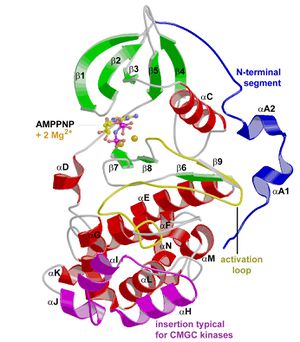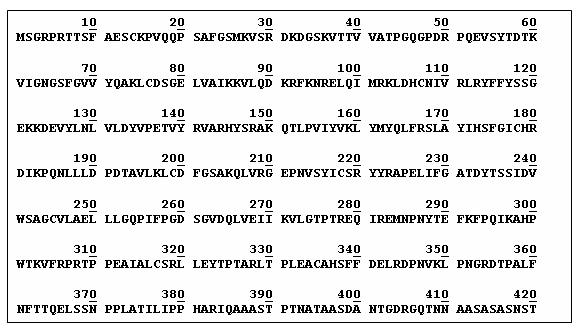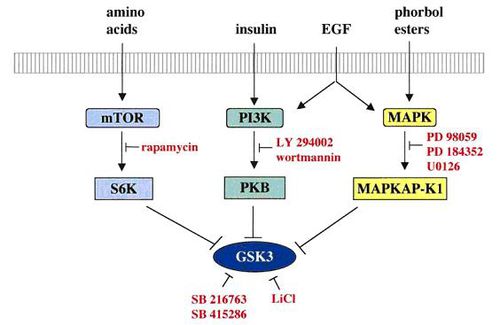Difference between revisions of "More details on GSK-3"
(→Overview) |
|||
| (14 intermediate revisions by one other user not shown) | |||
| Line 1: | Line 1: | ||
=Overview= | =Overview= | ||
| − | Glycogen synthase kinase-3 (GSK-3) has recently emerged, in the field of medicinal chemistry, as one of the most attractive therapeutic targets for the development of selective inhibitors as promising new drugs for numerous serious pathologies, including Alzheimer's disease, stroke, bipolar disorders, chronic inflammatory processes, cancer, alopecia and Type II diabetes. The full potential of GSK-3 inhibitors is yet to be realised and the number of drug candidates being developed by both academic centres and pharmaceutical companies has increased exponentially in the last three years. This review discloses recent discoveries on peptides and small molecules targeting GSK-3. Antisense therapy for the modulation of GSK-3 expression is also discussed. Focusing attention on this exciting target could thus reap considerable clinical and economic rewards. | + | Glycogen synthase kinase-3 (GSK-3) has recently emerged, in the field of medicinal chemistry, as one of the most attractive therapeutic targets for the development of selective inhibitors as promising new drugs for numerous serious pathologies, including Alzheimer's disease, stroke, bipolar disorders, chronic inflammatory processes, cancer, alopecia and Type II diabetes. The full potential of GSK-3 inhibitors is yet to be realised and the number of drug candidates being developed by both academic centres and pharmaceutical companies has increased exponentially in the last three years. This review discloses recent discoveries on peptides and small molecules targeting GSK-3. Antisense therapy for the modulation of GSK-3 expression is also discussed. Focusing attention on this exciting target could thus reap considerable clinical and economic rewards. [http://www.expertopin.com/doi/abs/10.1517/13543776.16.6.773 source] |
| − | |||
'''Protein name:'''Glycogen synthase kinase-3 alpha | '''Protein name:'''Glycogen synthase kinase-3 alpha | ||
| + | |||
'''Synonyms: '''EC 2.7.11.26; GSK-3 alpha | '''Synonyms: '''EC 2.7.11.26; GSK-3 alpha | ||
| + | |||
'''Gene name :'''Name: GSK3A | '''Gene name :'''Name: GSK3A | ||
| + | |||
'''From :''' Homo sapiens (Human) [TaxID: 9606] | '''From :''' Homo sapiens (Human) [TaxID: 9606] | ||
| + | |||
'''Function:''' Participates in the Wnt signaling pathway. Implicated in the hormonal control of several regulatory proteins including glycogen synthase, MYB and the transcription factor JUN. Phosphorylates JUN at sites proximal to its DNA-binding domain, thereby reducing its affinity for DNA. | '''Function:''' Participates in the Wnt signaling pathway. Implicated in the hormonal control of several regulatory proteins including glycogen synthase, MYB and the transcription factor JUN. Phosphorylates JUN at sites proximal to its DNA-binding domain, thereby reducing its affinity for DNA. | ||
==Structural details == | ==Structural details == | ||
| − | * GSK3 has the typical two-domain kinase fold with a beta-strand domain (residues 25−138) at the N-terminal end and an alpha-helical domain at the C-terminal end (residues 139−343). | + | * GSK3 has the typical two-domain kinase fold with a beta-strand domain (residues 25−138) at the N-terminal end and an alpha-helical domain at the C-terminal end (residues 139−343). <br> |
| − | * The ATP-binding site is at the interface of the alpha-helical and beta-strand domain and is bordered by the glycine-rich loop and the hinge. | + | * The ATP-binding site is at the interface of the alpha-helical and beta-strand domain and is bordered by the glycine-rich loop and the hinge. <br> |
| − | * The activation loop (residues 200−226) runs along the surface of the substrate binding groove. | + | * The activation loop (residues 200−226) runs along the surface of the substrate binding groove. <br> |
| − | * The C-terminal 39 residues (residues 344−382) are outside the core kinase fold and form a small domain that packs against the alpha-helical domain. | + | * The C-terminal 39 residues (residues 344−382) are outside the core kinase fold and form a small domain that packs against the alpha-helical domain. <br>[[image:gsk3_2.jpg|right|300 px]] |
| − | * The beta-strand domain consists of seven antiparallel beta-strands: strands 2−6 form a -barrel that is interrupted between strand 4 and 5 by a short helix (residue 96−102) that packs against the beta-barrel. | + | * The beta-strand domain consists of seven antiparallel beta-strands: strands 2−6 form a -barrel that is interrupted between strand 4 and 5 by a short helix (residue 96−102) that packs against the beta-barrel. <br> |
| − | * This helix is conserved in all kinases, and two of its residues play key roles in the catalytic activity of the enzyme. Arg 96 is involved in the alignment of the two domains. Glu 97 is positioned in the active site and forms a salt bridge with Lys 85, a key residue in catalysis. | + | * This helix is conserved in all kinases, and two of its residues play key roles in the catalytic activity of the enzyme. Arg 96 is involved in the alignment of the two domains. Glu 97 is positioned in the active site and forms a salt bridge with Lys 85, a key residue in catalysis.<br> |
| + | * Molecular weight: 46744.3 <br> | ||
| + | * Theoretical pI: 8.98 <br> | ||
| + | * Total number of negatively charged residues (Asp + Glu): 41 <br> | ||
| + | * Total number of positively charged residues (Arg + Lys): 50 <br> | ||
| + | |||
| + | '''Atomic composition:''' | ||
| + | |||
| + | ** Carbon C 2085 <br> | ||
| + | ** Hydrogen H 3285 <br> | ||
| + | ** Nitrogen N 575 <br> | ||
| + | ** Oxygen O 618 <br> | ||
| + | ** Sulfur S 14 <br> | ||
| + | * Formula: C2085H3285N575O618S14 | ||
| + | * Total number of atoms: 6577 | ||
| + | |||
| + | '''Prediction search done on NetPhos 2.0 server for GSK3''' | ||
| + | |||
| + | Prediction search done on NetPhos 2.0 server, which produces neural network predictions for serine, threonine and tyrosine phosphorylation sites in eukaryotic proteins. | ||
| + | |||
| + | [[image:predication-gsk3.jpg|center|800 px]] | ||
| + | |||
| + | '''DISPHOS (Disorder-Enhanced Phosphorylation Sites Predictor) Results''' | ||
| + | |||
| + | [[image:predication-gsk3-2.jpg|center|800 px]] | ||
| + | |||
| + | ==Amino Acid Sequence== | ||
| + | |||
| + | GSK3B_HUMAN consists of 420 amino acids sequemnce. | ||
| + | |||
| + | [[image:gsk-3 sequence.jpg|center|800 px]] | ||
| + | |||
| + | == Ways to inhibit GSK3== | ||
| + | Possible ways in the art to inihibit GSK3 is illustrated in following figure: | ||
| + | |||
| + | [[image:ways to inhibit gsk3.jpg|center|500 px]] | ||
| + | |||
| + | =Beta-catenin= | ||
| + | |||
| + | ==Structure== | ||
| + | Beta-catenin consists of 781 amino acid residue. | ||
| + | |||
| + | [[image:catenin.jpg|500 px|center]] | ||
| + | |||
| + | '''Amino Acid Sequence''' | ||
| + | |||
| + | 1 MATQADLMEL DMAMEPDRKA AVSHWQQQSY LDSGIHSGAT TTAPSLSGKG NPEEEDVDTS <br> | ||
| + | 61 QVLYEWEQGF SQSFTQEQVA DIDGQYAMTR AQRVRAAMFP ETLDEGMQIP STQFDAAHPT<br> | ||
| + | 121 NVQRLAEPSQ MLKHAVVNLI NYQDDAELAT RAIPELTKLL NDEDQVVVNK AAVMVHQLSK<br> | ||
| + | 181 KEASRHAIMR SPQMVSAIVR TMQNTNDVET ARCTAGTLHN LSHHREGLLA IFKSGGIPAL<br> | ||
| + | 241 VKMLGSPVDS VLFYAITTLH NLLLHQEGAK MAVRLAGGLQ KMVALLNKTN VKFLAITTDC<br> | ||
| + | 301 LQILAYGNQE SKLIILASGG PQALVNIMRT YTYEKLLWTT SRVLKVLSVC SSNKPAIVEA<br> | ||
| + | 361 GGMQALGLHL TDPSQRLVQN CLWTLRNLSD AATKQEGMEG LLGTLVQLLG SDDINVVTCA<br> | ||
| + | 421 AGILSNLTCN NYKNKMMVCQ VGGIEALVRT VLRAGDREDI TEPAICALRH LTSRHQEAEM<br> | ||
| + | 481 AQNAVRLHYG LPVVVKLLHP PSHWPLIKAT VGLIRNLALC PANHAPLREQ GAIPRLVQLL<br> | ||
| + | 541 VRAHQDTQRR TSMGGTQQQF VEGVRMEEIV EGCTGALHIL ARDVHNRIVI RGLNTIPLFV<br> | ||
| + | 601 QLLYSPIENI QRVAAGVLCE LAQDKEAAEA IEAEGATAPL TELLHSRNEG VATYAAAVLF<br> | ||
| + | 661 RMSEDKPQDY KKRLSVELTS SLFRTEPMAW NETADLGLDI GAQGEPLGYR QDDPSYRSFH<br> | ||
| + | 721 SGGYGQDALG MDPMMEHEMG GHHPGADYPV DGLPDLGHAQ DLMDGLPPGD SNQLAWFDTD<br> | ||
| + | 781 l | ||
| + | |||
| + | ==Role of beta catenin== | ||
| + | |||
| + | * Stabilized β-catenin can induce new hair follicles and trichofolliculoma-like tumors in skin. [http://www.pubmedcentral.nih.gov/articlerender.fcgi?artid=154144#B33 source] | ||
| + | * Follicular (hair) and epidermal stem cells are located in the bulge region. | ||
| + | * In the absence of β-catenin, stem cells can differentiate into the epidermal lineage but not into the hair follicular lineage. [http://www.pubmedcentral.nih.gov/articlerender.fcgi?artid=154144 source] | ||
| + | * In a research, expression of stabilized β-catenin in the epidermis of transgenic mice resulted in hair follicle morphogenesis. [http://www.biomedcentral.com/1471-2121/7/4#B8 source] | ||
| + | |||
| + | |||
| + | |||
| + | [[image:in action.jpg|center|400 px]] | ||
Latest revision as of 07:05, 14 July 2006
Contents
[hide]- [+]1 Overview
- [+]2 Beta-catenin
Overview
Glycogen synthase kinase-3 (GSK-3) has recently emerged, in the field of medicinal chemistry, as one of the most attractive therapeutic targets for the development of selective inhibitors as promising new drugs for numerous serious pathologies, including Alzheimer's disease, stroke, bipolar disorders, chronic inflammatory processes, cancer, alopecia and Type II diabetes. The full potential of GSK-3 inhibitors is yet to be realised and the number of drug candidates being developed by both academic centres and pharmaceutical companies has increased exponentially in the last three years. This review discloses recent discoveries on peptides and small molecules targeting GSK-3. Antisense therapy for the modulation of GSK-3 expression is also discussed. Focusing attention on this exciting target could thus reap considerable clinical and economic rewards. source
Protein name:Glycogen synthase kinase-3 alpha
Synonyms: EC 2.7.11.26; GSK-3 alpha
Gene name :Name: GSK3A
From : Homo sapiens (Human) [TaxID: 9606]
Function: Participates in the Wnt signaling pathway. Implicated in the hormonal control of several regulatory proteins including glycogen synthase, MYB and the transcription factor JUN. Phosphorylates JUN at sites proximal to its DNA-binding domain, thereby reducing its affinity for DNA.
Structural details
- GSK3 has the typical two-domain kinase fold with a beta-strand domain (residues 25−138) at the N-terminal end and an alpha-helical domain at the C-terminal end (residues 139−343).
- The ATP-binding site is at the interface of the alpha-helical and beta-strand domain and is bordered by the glycine-rich loop and the hinge.
- The activation loop (residues 200−226) runs along the surface of the substrate binding groove.
- The C-terminal 39 residues (residues 344−382) are outside the core kinase fold and form a small domain that packs against the alpha-helical domain.
- The beta-strand domain consists of seven antiparallel beta-strands: strands 2−6 form a -barrel that is interrupted between strand 4 and 5 by a short helix (residue 96−102) that packs against the beta-barrel.
- This helix is conserved in all kinases, and two of its residues play key roles in the catalytic activity of the enzyme. Arg 96 is involved in the alignment of the two domains. Glu 97 is positioned in the active site and forms a salt bridge with Lys 85, a key residue in catalysis.
- Molecular weight: 46744.3
- Theoretical pI: 8.98
- Total number of negatively charged residues (Asp + Glu): 41
- Total number of positively charged residues (Arg + Lys): 50
Atomic composition:
- Carbon C 2085
- Hydrogen H 3285
- Nitrogen N 575
- Oxygen O 618
- Sulfur S 14
- Carbon C 2085
- Formula: C2085H3285N575O618S14
- Total number of atoms: 6577
Prediction search done on NetPhos 2.0 server for GSK3
Prediction search done on NetPhos 2.0 server, which produces neural network predictions for serine, threonine and tyrosine phosphorylation sites in eukaryotic proteins.
DISPHOS (Disorder-Enhanced Phosphorylation Sites Predictor) Results
Amino Acid Sequence
GSK3B_HUMAN consists of 420 amino acids sequemnce.
Ways to inhibit GSK3
Possible ways in the art to inihibit GSK3 is illustrated in following figure:
Beta-catenin
Structure
Beta-catenin consists of 781 amino acid residue.
Amino Acid Sequence
1 MATQADLMEL DMAMEPDRKA AVSHWQQQSY LDSGIHSGAT TTAPSLSGKG NPEEEDVDTS
61 QVLYEWEQGF SQSFTQEQVA DIDGQYAMTR AQRVRAAMFP ETLDEGMQIP STQFDAAHPT
121 NVQRLAEPSQ MLKHAVVNLI NYQDDAELAT RAIPELTKLL NDEDQVVVNK AAVMVHQLSK
181 KEASRHAIMR SPQMVSAIVR TMQNTNDVET ARCTAGTLHN LSHHREGLLA IFKSGGIPAL
241 VKMLGSPVDS VLFYAITTLH NLLLHQEGAK MAVRLAGGLQ KMVALLNKTN VKFLAITTDC
301 LQILAYGNQE SKLIILASGG PQALVNIMRT YTYEKLLWTT SRVLKVLSVC SSNKPAIVEA
361 GGMQALGLHL TDPSQRLVQN CLWTLRNLSD AATKQEGMEG LLGTLVQLLG SDDINVVTCA
421 AGILSNLTCN NYKNKMMVCQ VGGIEALVRT VLRAGDREDI TEPAICALRH LTSRHQEAEM
481 AQNAVRLHYG LPVVVKLLHP PSHWPLIKAT VGLIRNLALC PANHAPLREQ GAIPRLVQLL
541 VRAHQDTQRR TSMGGTQQQF VEGVRMEEIV EGCTGALHIL ARDVHNRIVI RGLNTIPLFV
601 QLLYSPIENI QRVAAGVLCE LAQDKEAAEA IEAEGATAPL TELLHSRNEG VATYAAAVLF
661 RMSEDKPQDY KKRLSVELTS SLFRTEPMAW NETADLGLDI GAQGEPLGYR QDDPSYRSFH
721 SGGYGQDALG MDPMMEHEMG GHHPGADYPV DGLPDLGHAQ DLMDGLPPGD SNQLAWFDTD
781 l
Role of beta catenin
- Stabilized β-catenin can induce new hair follicles and trichofolliculoma-like tumors in skin. source
- Follicular (hair) and epidermal stem cells are located in the bulge region.
- In the absence of β-catenin, stem cells can differentiate into the epidermal lineage but not into the hair follicular lineage. source
- In a research, expression of stabilized β-catenin in the epidermis of transgenic mice resulted in hair follicle morphogenesis. source





